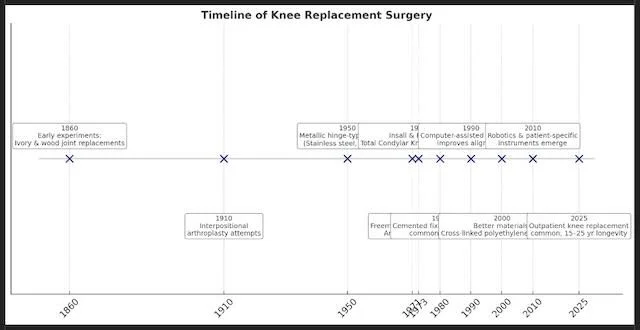Knee Replacement 2: What Do We Know?
Now that I know I’m committed to knee replacement surgery, I need to understand what the procedure actually entails, how it works, and who it benefits. But I don’t really want to know ALL of that. I don’t need videos of power drills boring femurs, chisels chipping patella, or bone saws splattering blood. For now, let’s just skip past the bashing of steel rods into human marrow. Of course, with a few clicks, you can see all of this on YouTube, but I’m not taking the clickbait for three reasons: 1. I’m a highly visual person. 2. I’m really good at scaring the shit out of myself. 3. Though I really need to be brave enough to create a better future me, if today’s me actually saw all that shit, I’d turtle.
Future Bill can learn to put cool stickers on his walker.
A guy’s got to know his limitations, right? So, let’s start somewhere safer, perhaps a brief history of knee replacement. Tickling ChatGPT, serves up a graphical timeline that doesn’t involve a single blood-soaked sinew.
Interesting, but what about success rates?
The little Open AI angel claims that improved materials (I’m glad they’re no longer using ivory, but how badass would it be to have elephant tusk in your knee?), such as polyethylene, titanium, and ceramic, have increased implant durability and reduced wear. The bot tells me that minimally invasive approaches—smaller incisions and less muscle disruption—have improved recovery time and that CT- and MRI-scan-guided robots are routinely used to cut and sew. Apparently, enhanced pain management and rehab now allow some patients to go home the same day. A claim is made that more than a million knee replacements are performed annually, that the implants last 15–25 years, and with over 90% patient satisfaction, the operation is considered one of the most successful in modern medicine.
Okay, I’m getting data I can roll with.
Of course, I don’t check the veracity of any of this. I’ve made my decision—I’m willing to sacrifice some time now, and submit to risk, to bet on an improved quality of life for the next couple of decades. I was just looking for data to fortify the decision. Isn’t that what we all do these days? Find the data to support the decisions we’ve already made? I’m leaning into this thing, but I’m not done yet. I promised myself I’d follow my own plodding evaluative steps, just like I would when launching any other adventure.
Next up, ROI of KR (Knee Replacement).
